Bhaja Pithe is a Bengali sweet dish aka Pithe made with a filling of coconut and date palm jaggery. The stuffing is encased in a shell made of yellow split lentils, rice flour, and Sweet Potato. It is then deep-fried and served during the winter months. The shell of the sweet is light and crispy, while the filling is sweet and sticky, making it a perfect winter treat.

Jump to:
- Bhaja Pithe from my mother's kitchen
- Poush Parbon
- Bhaja Pithe aka Moong Daaler Bhaja Puli
- Patali Gur, an important ingredient
- Ingredients
- How to make perfect Bengali Bhaja Pithe
- Variations
- Equipment needed to make Bengali Pithe
- How to store Bengali Bhaja Pitha
- Top tip
- Frequently Asked Questions
- Related Pithe Puli Recipes
- Poush Sankranti Recipes
- Authentic Bengali Bhaja Pithe aka Moong Pooli Recipe Video
- Let's connect over traditional Bengali Poush Sankranti special Pithe Recipe
- Moong Daal-er Bhaja Pithe Recipe Pin for You
Bhaja Pithe from my mother's kitchen
Maa made Bhaja Pithe after ages during Poush Parbon and it was a moment of joy for us. I had requested her to make it for us and was so glad that she obliged. I was extra careful to capture all the moments of her making it and she even asked me to capture the intricate details of the making of the Bengali Bhaja Puli. It is customary to make Pithe Puli during Poush Parbon, however, this year I was initially planning to skip it considering Baba's health condition. He was hospitalized for a long time. It was quite a tough two months for the entire family.

The past three months had been extremely challenging for our whole family. However, I eventually realized that we needed to bring a sense of normalcy back into our lives. We needed it as a family to help us cope with the difficult situation. Therefore, I decided to honor the tradition and ask Maa to make the Bhaja Pithe. We all ate it together with joy, and it brought us a sense of comfort and togetherness. I must mention, Mehebub was a great help all through.
Poush Parbon
Poush is the ninth month of the Bengali calendar and it marks the beginning of the winter season. Paush Utsav is a month-long celebration that starts on the first day of the month and ends on the last day, Poush Sankranti. It is a harvest festival celebrated in West Bengal and is also known as the Winter Festival in Bengal.

During this month, we (Bengalis) make a variety of traditional treats such as Pithe, Payesh, and other delights using seasonal Date Palm Jaggery, also known as Patali Gur.
Every year, we celebrate Makar Sankranti in the month of January. To commemorate this occasion, people in West Bengal make certain delicacies, the most popular being various types of Pithe Puli.
In this blog post, I will share the recipe for the iconic Bhaja Pithe.
Bhaja Pithe aka Moong Daaler Bhaja Puli

Bhaja Pithe, also known as Moong Puli, is an iconic Bengali Pithe. This delectable sweet dish is prepared with a filling of Coconut and Date Palm Jaggery, also known as Patali Gur, which is encased in a shell made of Yellow Split lentil, also known as Moong Dal, and Rice Flour. We use Sweet Potato aka Rangaaloo as a binding agent while making the dough. It enhances the flavor as well.
Patali Gur, an important ingredient
This is then deep fried and served during the winter months when Patali Gur is at its best. The shell of the sweet is light and crispy, while the filling is sweet and sticky, making it a perfect winter treat. The contrast of textures between the shell and the filling makes this dish a unique and special one.
Ingredients
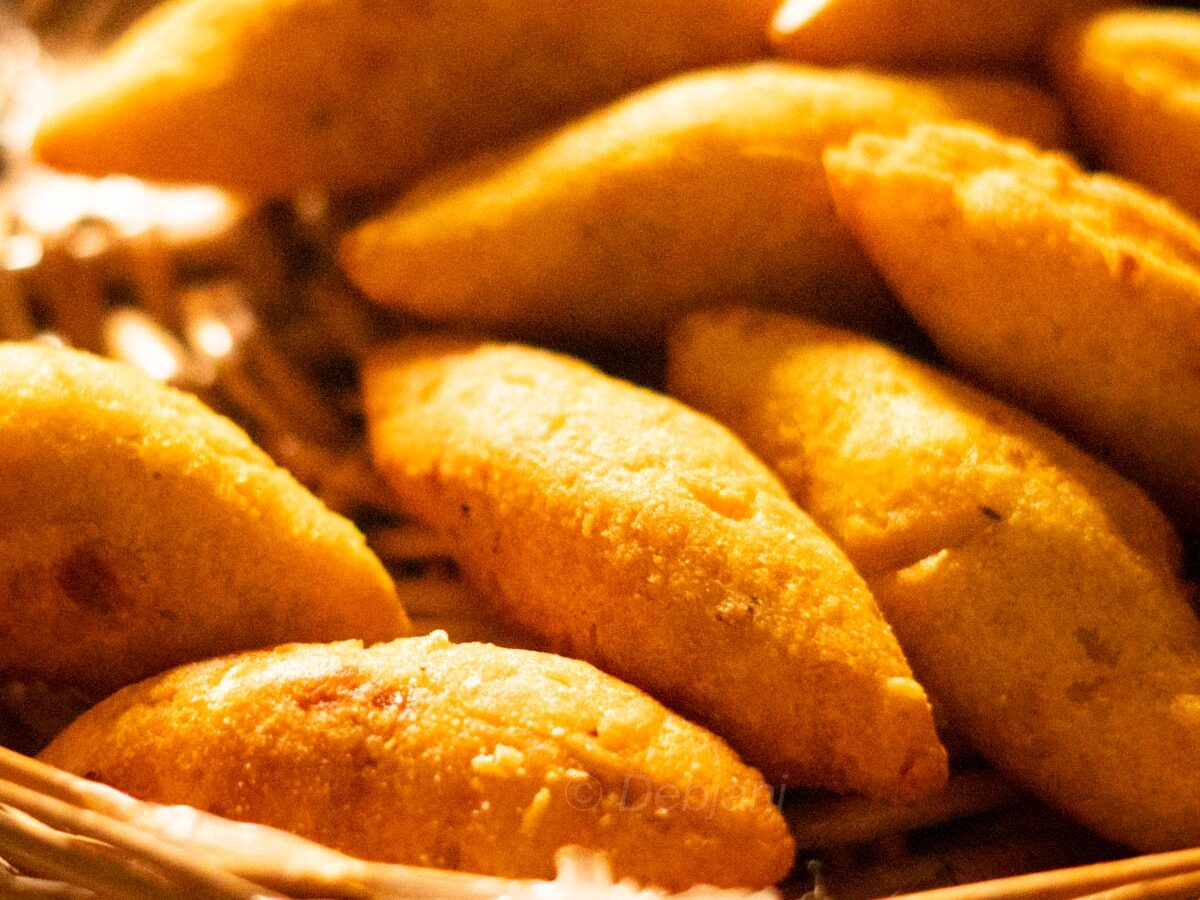
- Moong Daal
- Sweet Potato
- Rice Flour
- Date Palm Jaggery
- Coconut
- Salt
- Turmeric Powder
- Vegetable Oil
See the recipe card for quantities.
How to make perfect Bengali Bhaja Pithe
At home, we prepare the stuffing of bhaja pithe with fresh coconut and patali Gur. We made this filling after finely grating the coconut until it is almost like a paste and then adding the jaggery to it. However, the filling is slightly different for Nonta Pithe aka Savory Pitha, where we use a savory stuffing. It is then cooked until the mixture is dry.

In this blog post, I am sharing pictures and details about the traditional process of scrapping coconut here. You can choose to follow the traditional method, which involves using a handheld scraper to scrape the coconut, or you can opt for a more convenient option and use packaged coconut instead. The latter option is definitely more time-saving. Once the coconut is scraped and the filling is ready, you can use it to make a variety of sweet and savory pithas, as per your choice!
Steps

This is the traditional process of breaking the coconut.

We have used a traditional coconut scrapper to scrap the coconut.
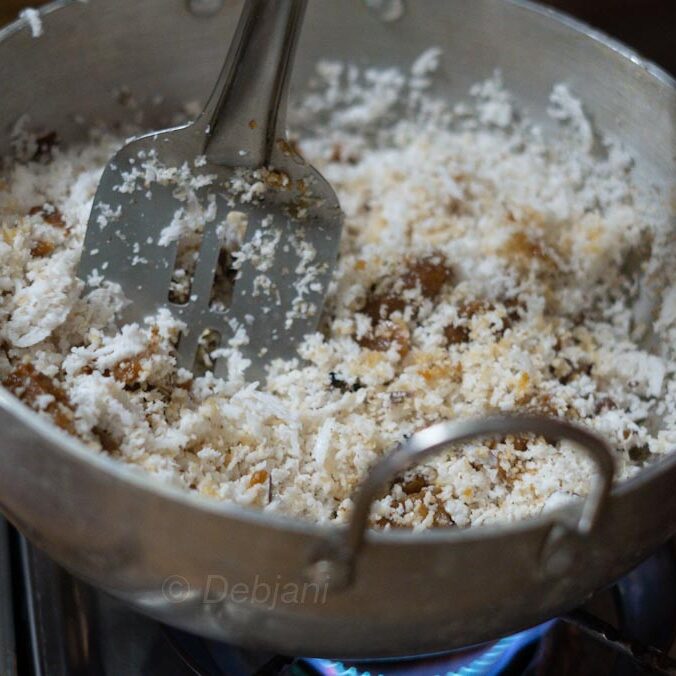
Making of Stuffing combining coconut and Patali Gur. Check the Recipe card for measurement and time.

Here! you can see the consistency of the stuffing.

We use unpolished small moong dal, also known as Bengali Sona Moong Dal to make the dough.

In my place, we add sweet potato while making the dough to make it pliable.

It is a must to pressure cook the daal with a specific amount of water to make it soft.

We prepare this dough with boiled daal, sweet potato, and rice flour along with a few spices. Do check both the recipe card and recipe video of Moong Pooli I have given below to understand the texture needed for making perfect Pithe.

A flattened disk of dough ready to be filled with stuffing.

This picture may help you to understand the process of making the flattened disk with Daal mixture to make pithe.

Here! look into the shape.
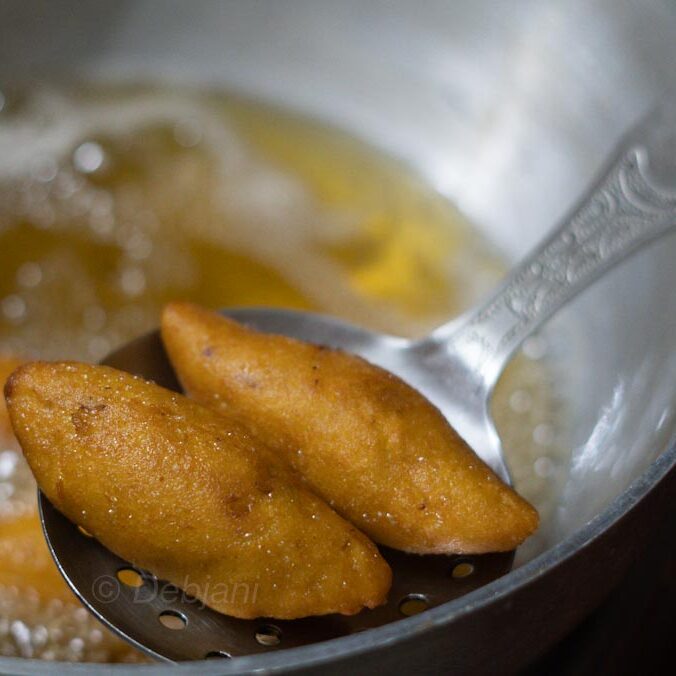
We deep-fry Bhaja Pithe. Bhaja, in fact, is stands for fried.
Variations
- Sweet Potato is optional while making Bhaja Puli; though it works as a binding agent and gives a lovely flavor to the pitha.
- Instead of Patali Pur, you can use sugar to make the stuffing with coconut.
- Another variation of Bhaja Pithe is Nonta Pitha (also known as Savory Pitha). The recipe and flavors are completely different, and hence, I do not consider that as a typical variation but a different dish altogether.
Equipment needed to make Bengali Pithe
In the case of this Bengali Bhaja Pithe recipe, we have used a traditional coconut scrapper to scrap the coconut. This is essential to the recipe as it helps to ensure the coconut is the right consistency and texture. We have also used a pressure cooker to boil the lentil. This is an effective and efficient way to do it and can save time, however, if you don't have a pressure cooker you can use a heavy-bottomed utensil to boil the daal. This will take longer, but it will work.
Finally, for frying, we have used a traditional Lohar Korai (Iron Wok aka Iron Kadhai). This is a great way to fry the ingredients as it ensures that the heat is evenly distributed and that the food is cooked through. Using traditional cooking methods and utensils can make a big difference to the final product, so it's important to pay attention to the equipment you are using.
How to store Bengali Bhaja Pitha
You can store Bhaja Pithe easily for 10 days in the refrigerator.
Top tip
Making the perfect bhaja pithe requires a few important ingredients. The most important of these is freshly scraped coconut, which when cooked with the seasonal Patali Gur, makes for a truly divine dish. It is essential to ensure that the highest quality of Moong Daal is used when preparing bhaja pithe. If you are not a resident of West Bengal, try to procure the renowned Shona Moong Daal from the market or a Bengali store. This will ensure that the final product is nothing short of perfection. In the end, the combination of freshly scraped coconut and Shona Moong Daal cooked with Patali Gur will transform your bhaja pithe into something truly special.
Frequently Asked Questions
Shona Moong Daal is a type of yellow split pea that is smaller and of better quality. It costs more than a regular yellow split pea and in Bengali cooking, we use it frequently. In Delhi, I have seen this daal available in C R Park. I am sure in other Indian cities, Shona Moong Daal will be available in Bengali stores and outside of India, you can try Bengali stores. If not available, try a smaller variety of moong dal, preferably the best quality available.
Yes, I do prepare the coconut and Patali Gur stuffing in large quantities. This allows me to make various types of pitha, such as patishapta, gokul pithe, dudh Puli, bhapa pithe, and more, all at once. Making the stuffing in bulk is a more efficient approach compared to making each type of pitha separately. It not only saves time and effort, but also ensures that the consistency and quality of the stuffing remain consistent across all types of pitha.
Related Pithe Puli Recipes
Looking for other Bengali Pithe Puli Recipes? Try these:
Poush Sankranti Recipes
These are my favorite dishes for Push Sankranti

Bhaja Pithe
- Total Time: 1 hour
- Yield: 50 Pitha 1x
- Diet: Vegetarian
Description
Bhaja Pithe is a Bengali Pitha made with a filling of coconut and date palm jaggery. The stuffing is encased in a shell made of yellow split lentils and rice flour. It is then deep-fried and served during the winter months. The shell of the sweet is light and crispy, while the filling is sweet and sticky, making it a perfect winter treat.
Ingredients
For the Stuffing
- 2 Coconut
- 350g Date Palm Jaggery/ Patali Gur
To make the Outer crust
- 600g Moong Daal (dhuli)/ Shona Moong Daal
- 500g Rice Flour
- 1 Sweet Potato/ Rangaloo
- ⅓ Tsp. Turmeric Powder
- 1 Tsp. Sugar
- ½ Tsp. Salt
To Fry Bhaja Pithe
- 350ml Vegetable Oil
Instructions
Stuffing
- Take two coconuts and after breaking those scrap the coconuts.
- Please note with 2 coconuts and 350g patali gur you will make coconut stuffing in bulk to make around 60 Pithas. To make less, use one coconut and 175g of Gur instead.
- Take the scrapped coconut to a pan and cook for 2 minutes on low flame.
- Now add 350g Patali Gur aka Date Palm Jaggery.
- Mix the Gur with Coconut using a spatula (called Khunti in Bengali!).
- Keep mixing and cook for 7-8 minutes on low flame to make a sticky stuffing.
- This stuffing is known as "Chhai" in Bengali.
- Switch the flame off.
- Wait till the mixture comes to room temperature to use it further.
- You can make the stuffing beforehand and make pitha as and when needed.
Outer Shell of Bhaja Pitha
- Remove the skin of the Sweet Potato and cut it into small pieces.
- Now heat a pan and dry-roast the Moong daal on low flame.
- Do not over-roast the daal. 2 minutes would be sufficient.
- The moong deal must have a nice golden color after roasting Switch the flame off.
- Stir to avoid browning.
- Now add water and wash the daal at least 3 times and discard the water.
- Transfer washed daal to a pressure cooker.
- Now add ½ Tsp. Salt, 1 Tsp. Sugar, and also ⅓ Tsp. Turmeric Powder.
- Now add Sweet potato chunks.
- Add water to cover the daal. Do not add extra water. Please check the video recipe to understand the water level.
- Put the Lid on along with the vent weight.
- Cook on low flame till the pressure cooker releases pressure 3 times (3 whistles).
- Switch the flame off and open the lid when the pressure drops completely.
- Check the dal. It should be properly cooked with no extra moisture in the cooker by this time.
- Now start adding Rice Flour when the daal is hot.
- Start with 1 Cup and mix Add another cup of rice flour in between.
- Mash sweet potatoes properly.
- Transfer half of the dough to a flat surface.
- Keep adding rice flour and keep kneading.
- For the entire daal and sweet potato, you need around 500g of rice flour.
- The dough should be soft, and pliable yet smooth.
- Keep it covered with a wet cloth for 10 minutes before making the balls.
- Make small balls (2-inch diameter).
- You can see in the video how smooth these balls are.
- Around 50 balls will be made with the ingredients we have used.
Making Pitha
- Now take a ball, and flatten it slightly to give it the shape of a bowl.
- Fill it with 1 Tbsp. Stuffing.
- Seal it and give it the shape of a closed boat.
- You can see in the video that it is very easy to seal the pithe.
- Following this process shape the remaining moong pooli.
Frying Bhaja Pooli
- Now heat around 350ml of Vegetable Oil.
- Check the oil by frying a tiny portion of the dough.
- Depending on the diameter of the kadhai start frying 4-6 moong dealer bhaja pithe at one go.
- Keep the flame medium.
- Fry pithe till they turn golden in color.
- Flip in between.
- It will take around a minute to fry one batch.
- Strain moong pithe and fry the next batch.
- Serve Bhaja Pithe hot or at the room temperature.
- I prefer Bashi Pithe more! This means I prefer to keep the pithe at least for one day after frying and then serve it. This time helps the pithe to season.
Notes
- In the Bhaja Pithe recipe video, we have shown the traditional process of scrapping coconut. You can for sure use packaged coconut.
- Sweet Potato works as a binding agent and gives a subtle sweet flavor to the outer coating of bhaja pooli.
- Instead of a Pressure cooker, you can use another utensil to boil the daal. Using a pressure cooker is an effective and efficient way to do it and can save time. However, if you don't have a pressure cooker you can use a heavy-bottomed utensil to boil the daal. This will take longer, but it will work.
- In my family, we do not soak bhaja pithe in sugar syrup any further. Moongmasali (soaked Bhaja Pithe) is prepared separately at ours.
- Prep Time: 30
- Cook Time: 30
- Category: Dessert
- Method: Cooking
- Cuisine: Bengali
Nutrition
- Serving Size: 75g
- Calories: 183
- Sugar: 8.2g
- Sodium: 372mg
- Fat: 7.8g
- Saturated Fat: 5.2g
- Carbohydrates: 24.8g
- Fiber: 3.2g
- Protein: 4.2g
- Cholesterol: 0mg
Authentic Bengali Bhaja Pithe aka Moong Pooli Recipe Video
Let's connect over traditional Bengali Poush Sankranti special Pithe Recipe
I would love to see a picture if you are making the prawns following my recipe. You can share here at dolonchttrj@gmail.com. You can use my hashtag #debjanirrannaghar and share it through Instagram as well. and in addition, you can tag me at @foodofdebjani.
Moong Daal-er Bhaja Pithe Recipe Pin for You






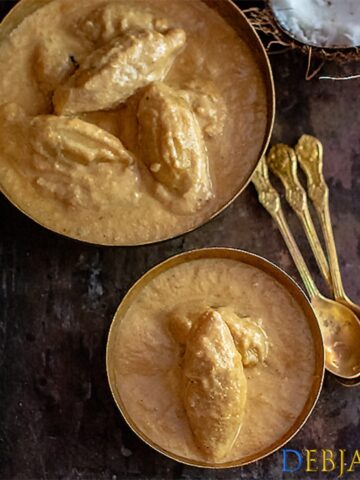







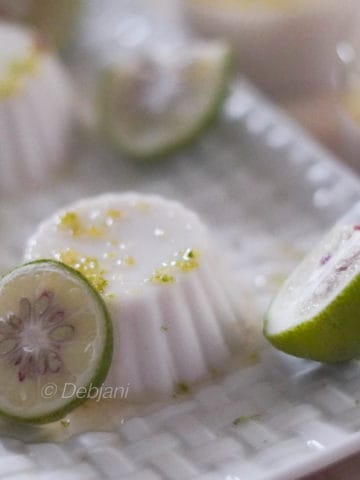


Leave a Reply